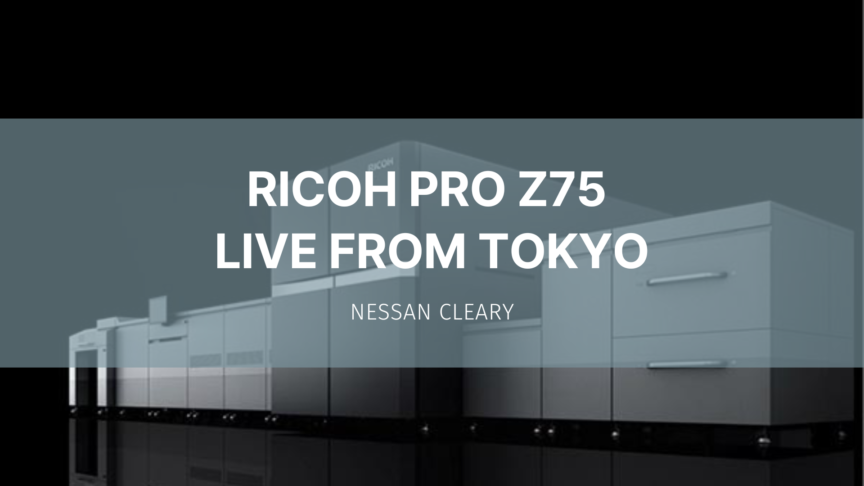Ricoh has finally got around to showing off its new B2 sheetfed single pass inkjet press, the Pro Z75, where it was right at the front of Ricoh’s stand at the recent IGAS show in Tokyo, after several years of talking about this press.

The press has been developed entirely by Ricoh, using the expertise in designing cut sheet paper transport systems gained from its dry toner presses, combined with its own printheads and ink technology as seen on the rollfed VC70000-series inkjet presses. The printheads are based on Ricoh’s Gen5 design as used in the VC70000 but with a more compact version to make for a better fit across the printbar. The idea is that operators will be able to replace the individual heads fairly easily, which presumably means that Ricoh will also implement some form of calibration so that replacement heads match the remaining heads in a given print bar. The print resolution is 1200 x 1200dpi. It uses 11 printheads per colour.
There are currently four colours – CMYK – but there is space to add a fifth colour. Ricoh is in the process of assessing feedback to see if it needs a fifth colour. Personally I think that it would have been more sensible to leave space for up to six colours, since just about every vendor that’s ever tried to convince journalists on the merits of a fifth colour station privately admit that they really wish they had six units.
The ink is a water-based pigment ink. The press uses two drying systems, including NIR plus a second system that Ricoh has understandably not disclosed because it it still awaiting the patent protection. There has been some suggestion that Ricoh could use a highly pigmented ink to avoid the need to put too much ink, and therefore water, onto the paper. However, the Gen5 printhead usually works with relatively low viscosity inks so even if Ricoh is using very vibrant pigments, there will still be a certain amount of water content in the ink, meaning that the efficiency of the drying system will determine the density of the ink coverage and the printing speed.
It will print to offset coated plus plain and inkjet coated paper from 60 to 400gsm without using any kind of primer. It takes B2 sheets up to 585 x 750mm. This is suitable for printing 6-up letter size pages, which will be fine for the US market, but not for 6-up A4 pages, which is likely to be less attractive for any potential European customers.
It can print 4500 images per hour, and includes full auto duplexing where the speed for double-sided printing is 2250 per hour. Ricoh sees Fujifilm’s Jetpress 750 as a major competitor and believes that the auto duplexing ability is a key differentiator. This speed is certainly faster than the Jet Press at its maximum 1200 dpi resolution though it’s worth noting that Fujifilm does offer higher speeds at lower resolutions.
Ricoh has one of these presses installed as a beta at an American commercial printer, Heeters, based in Canonsburg, Pennsylvania. The company is an established Ricoh customer, having first installed a Pro VC60000 inkjet webfed press back in 2015 and then become the first printer worldwide to install a Pro VC70000 back in 2018.
Takuya Yasuda from Ricoh’s technical marketing team told me that Heeters is already using the press partly for live production. He adds that the image quality on these prints is good but that Ricoh is still testing it.
However, Ricoh currently has no plans to test the Z75 in Europe, which seems to be mainly down to not having a machine available. I suspect that Ricoh will have to rethink this as other inkjet vendors have found that there can be quite some variation between the paper stocks available in the US and in Europe, not to mention a different mix of applications and customer expectations.
Ricoh says that the Pro Z75 will target a broad range of commercial print work including packaging, direct mail, posters and display graphics. That suggests that the press will have to be competitive against offset as well as other digital devices, such as the B2 HP Indigo 100K and 50K as well as Fujifilm’s Jet Press and Konica Minolta’s KM-1 series.
However, there’s no word yet on pricing as Ricoh is still studying the market. The company is also considering some form of click charge to cover servicing costs but not consumables or printing. Ultimately, whether or not Ricoh is successful at selling this press will depend on the running costs.
Otherwise, my main impression is that it is a very big machine for a B2 press though it does appear to have a very solid chassis. Several competitors pointed out that it was not actually printing anything at the show, but I don’t think that we can read anything into this as very few machines were running at IGAS. I believe that this is mainly down to the limited amount of time given to vendors to set their stands up for the show.
The press should be available in the second half of 2023. I’ve covered the basics in an earlier story and you can find further details on Ricoh’s other presses, but not yet the Z75, from ricoh.co.uk.

